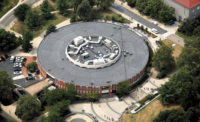Digital Adoption Ushers in a New Era of ‘Future-Ready’ in Roofing and Construction

Keeping today’s small and midsize roofing companies on track with marketplace changes and innovation is far more complicated than it was a generation ago. The labor pool is smaller, the supply chain is more complicated, demands on communication have multiplied, and sustainable, durable and “smart” construction are the new industry norms.
In this fast-moving environment, the old way of conducting business is not enough to keep up. The industry needs disruption with a focus on the future. And the future is digital.
Adopting technology-based solutions to disrupt inefficient, manual processes will deliver tangible benefits. Roofers and others in the construction trade who embrace digital tools will expand their time and productivity through improved efficiency. Operable from a smart phone or tablet, these tools are critical for powering business growth. They also reflect the ability to meet or even set the pace and expectations of the digital world where customers work and, increasingly, want to live.
However, much of the roofing and construction industry has not kept up with the digital world in which it builds. And, when it comes to being “future-ready,” the industry admits it largely isn’t.
According to a recent analysis of the industry’s adoption of digital technology, there is widespread agreement that digital transformation must happen. Nearly 90% of construction companies believe digitization will transform the industry and 70% believe those who don’t move to digital technologies will go out of business. Yet, 46% report their roofing or construction business either has not started to adopt digital technology or remains in the early stages of adoption.
What’s more, at a time when the industry’s steep global growth contrasts sharply with productivity that has remained nearly flat, 77% of builders believe that digitization will improve productivity. That leaves an estimated $1.6 trillion in revenue on the table due to a lack of digital adoption and, consequently, lost potential productivity.
One reason for this disconnect may be time or budget constraints that roofers, builders and other contractors say limit their ability to explore, learn and adopt new technology solutions. Other staff or subcontractors may be reluctant to use new tools, as discomfort with — and distrust of — unfamiliar technologies or new ways of doing business can often paralyze advances into digital solutions.
But in today’s world, homes are increasingly digital and old analog equipment has all but disappeared. And the trends of moving more towards a digital future are increasingly evident in consumer attitudes.
Samsung, for example, estimates consumers will spend $90 billion on digital smart-home technologies over the next four years. Building and roofing companies that aren’t digitized — in both equipment and process — will struggle to accommodate this demand from consumers and earn trust in this evolving environment.
The industry’s transformational shift can be seen among trends in job assessment, measurement and quotation. In the past, quoting construction and roofing work was an analog process involving a ladder, tape measure and notebook. It was time-consuming and prone to human error, often with diminished accuracy. However, using new technologies such as advanced aerial imagery and drones, this process can be completed digitally, from the safety of a desk, in a fraction of the time and with higher accuracy.
Such innovations allow roofers and contractors to deliver intelligent sales appointments at a client’s convenience, with 3-D renderings of the property, precise measurements and highly accurate quotes that instantly cite time, material options and costs. Better still, for both roofers and homeowners, the presentation is “future-ready,” provided electronically and ready for signing and scheduling.
Disrupting and digitizing the customer acquisition process also saves money. Underbidding or overbidding a job due to measurement inaccuracies can conservatively cost several hundred dollars, whereas a modest investment in an aerial imagery-based roof report costs far less per project and can pay dividends over a job’s lifecycle. The payback in digital adoption comes in many forms, including recovered time and productivity, more accurate measurements that lead to correct estimates, precise purchasing, improved safety and fewer accidents.
Bringing measurement and estimation into the digital age can transform some of the most time-consuming, dangerous tasks into competitive, productivity-gaining differentiators, ultimately keeping employees safer, impressing customers and driving scale.
In the roofing and construction industry, it’s time to look beyond the analog age to embrace a more digital future.
Michael Park is the Chief Product and Marketing Officer of EagleView, a leading provider of aerial imagery and property data analytics for the government, insurance, construction and energy sectors.
Looking for a reprint of this article?
From high-res PDFs to custom plaques, order your copy today!






